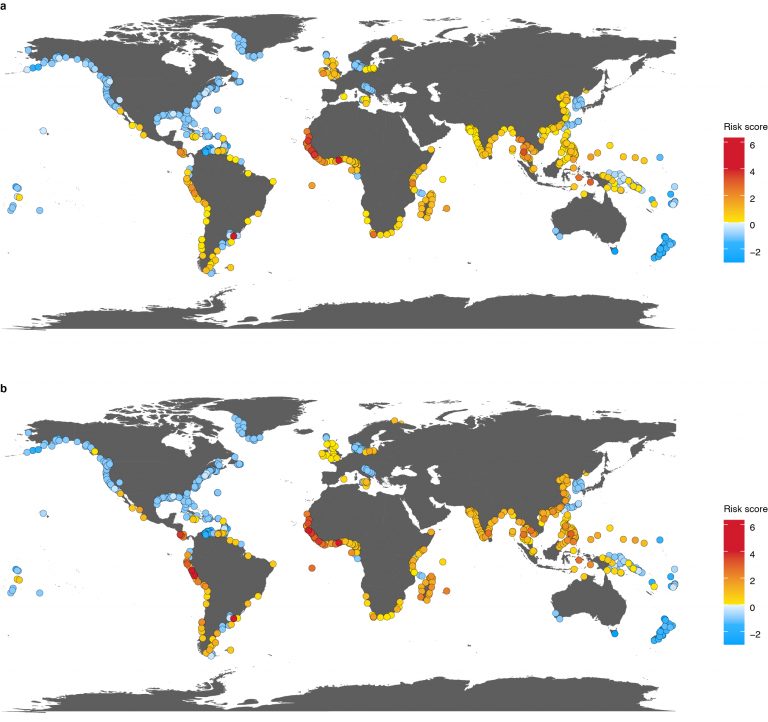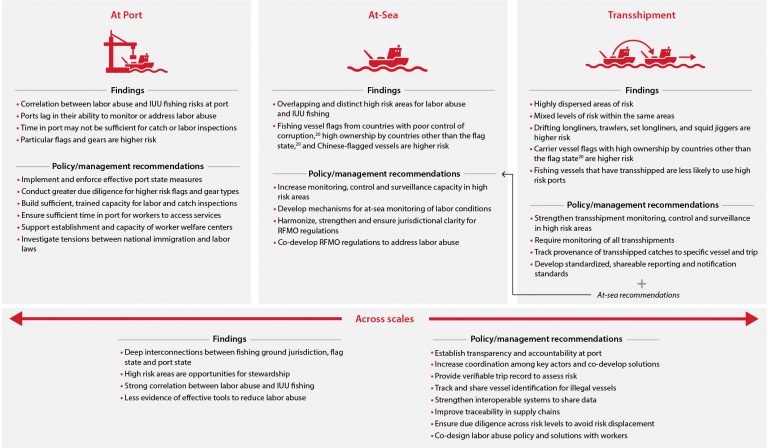A new modeling approach combines machine learning and human insights to map the regions and ports most at risk for illicit practices, like forced labor or illegal catch, and identifies opportunities for mitigating such risks.

Risk maps for labor abuse and illegal, unregulated and unreported fishing at port. The maps indicate risk scores of ports assessed in the survey for (a) labor abuse and (b) illegal, unregulated and unreported fishing. Blue indicates lower port risk scores and red denotes higher risk scores.
Using an online survey of experts, the researchers also found that labor abuse and illegal, unreported and unregulated (IUU) fishing are globally pervasive: Of more than 750 ports assessed around the world, 57% are associated with risks of labor abuse or IUU fishing. However, in addition to revealing the global extent of these risks, the study also highlights potential pathways to reduce these risks through actions at port that detect and respond to labor abuse and deter the landing of illegally caught fish.

Colette Wabnitz
“Major seafood companies are now able to understand where risks are greatest in order to help them meet their commitments to remove labor abuse and illegal fishing from their supply chains,” said co-author Henrik Österblom, science director at the Stockholm Resilience Centre, who heads the science team advising SeaBOS, an initiative that includes the world’s ten largest seafood companies.
Remote risk prediction
Given limited surveillance and enforcement capacity, the high seas – or the waters beyond a country’s jurisdiction – have long provided a safe haven for IUU fishing. Every year, millions of tons of fish are caught illegally. Vessels engaged in IUU fishing often also have labor abuses on board including subjecting workers to forced labor, debt bondage, and poor working conditions.
The study team chose to assess risk, or the possibility that illegal activities might be happening in a specific area, rather than predict case numbers due to the challenge of identifying which vessels are involved in illegal activities at any given time and the need to manage risks more broadly across fleets.
To investigate risk, the authors paired human insights with big data. An anonymous survey distributed to experts from seafood companies, research institutions, human rights organizations and governments helped quantify the degree of certainty around whether particular ports were associated with either labor abuse or IUU fishing. Using machine learning, the team then combined survey responses with satellite-based vessel-tracking data curated by Global Fishing Watch to identify higher-risk regions associated with transshipment, where crew and catches are exchanged between vessels, and at sea.
For fishing vessels, coastal regions off West Africa, Peru, the Azores, Argentina and the Falkland Islands had higher risks for labor abuse and IUU fishing. The model also revealed that vessels registered to countries that have poor control of corruption, vessels owned by countries other than the flag state and vessels registered to China have a higher risk of engaging in illegal activities. Chinese-flagged vessels, comprising the world’s largest fishing fleet, dominated the data and were thus analyzed separately. For transshipment, certain fishing gear types – like drifting longliners, set longliners, squid jiggers and trawlers – were found to be higher risk.
The study also showed a strong presence of foreign-flagged vessels in fishing grounds thousands of miles away from where they bring their catch to port. This suggests that ports with weak monitoring standards can incentivize illegal activities far away, highlighting the need for coordinated regional action.

Conceptual framework linking results to key recommendations for mitigating risks of labor abuse and IUU fishing at port, at sea, and associated with transshipment. Key actors—including governments, companies, regional fisheries management organizations, and civil society organizations—will need to actively coordinate, consult with each other and lead on proposed recommendations where they have jurisdiction.
The promise of ports
All voyages begin and end in port. These bustling stopovers serve as critical hubs where officials can monitor and enforce legal frameworks that govern labor and catch. The study team analyzed the effectiveness of port measures for mitigating risks of these illegal practices. For labor abuse, they analyzed how long vessels spend in port, finding that riskier vessels have shorter port durations, which reduces the odds that port officials can intervene or that workers can access port services.
For IUU fishing, the team examined how vessel visits changed after the Port State Measures Agreement (PSMA) – which stipulates inspection standards, data exchange and port entry denial when appropriate for foreign-flagged vessels – entered into force in 2016. In the year after the PSMA took effect, the team found that fewer risky vessels visited countries that had ratified PSMA measures compared to countries that did not.
“Port state measures offer a lot of promise, but they need to be implemented effectively and, ideally comprehensively across regions, so that vessels cannot easily escape scrutiny by going to a port in a neighboring country,” said Selig.
Other co-authors include Shinnosuke Nakayama from the Stanford Center for Ocean Solutions; Henrik Österblom from the Stockholm Resilience Centre at Stockholm University and The University of Tokyo; Jessica Spijkers from the ARC Centre of Excellence for Coral Reef Studies at James Cook University and the Stockholm Resilience Centre at Stockholm University; Nathan Miller from Global Fishing Watch; Jan Bebbington from The Pentland Centre at Lancaster University; and Jessica Sparks from the University of Nottingham Rights Lab.
The research was supported by The David and Lucile Packard Foundation, the Walton Family Foundation and the Gordon and Betty Moore Foundation.
Tags: Colette Wabnitz, CORU, fish stocks, Illegal fishing, IOF Research Associates, IUU, slavery